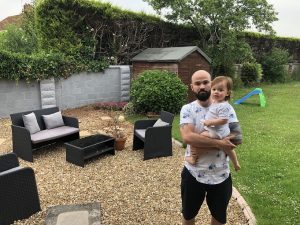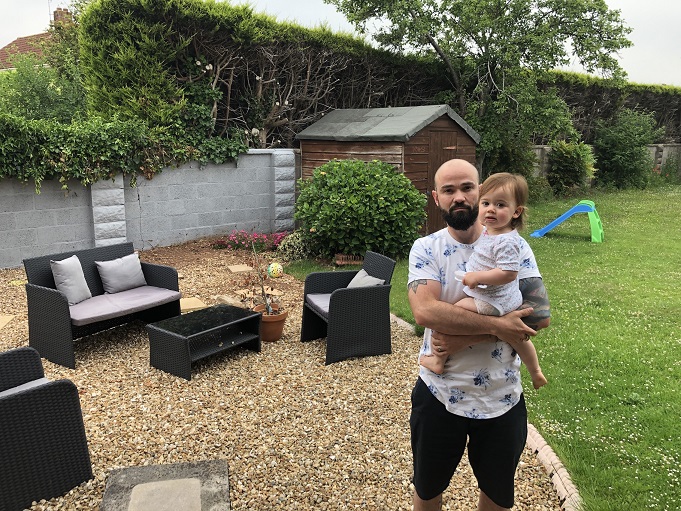A home buyer from Somerset has revealed how his mortgage application was put in jeopardy when the lender discovered the presence of an invasive plant in his new property.

Joe Wigzell, 37, was informed by the estate agent when he viewed the bungalow in Weston-super-Mare about the presence of the scourge known as Japanese knotweed.
However, it wasn’t until he spoke with his mortgage lender he discovered the full implication of the growth.
In fact, mortgage and equity release lenders take a very cautious approach to homes which have evidence of Japanese knotweed. This is because it can grow quickly and powerfully and can therefore cause great damage to properties.
What’s more, knotweed is very difficult to tackle and requires a specialist service and long-term treatment plan to ensure it doesn’t pose a risk to surrounding properties.
To make the situation even more complex, the plant is also tricky to identify and, according to experts at knotweed treatment and removal firm, Environet, many people confuse it with bindweed.
In Joe’s case, Japanese knotweed was something with which he was completely unfamiliar.
“Before buying my new home I didn’t know anything about Japanese knotweed and the damage it can cause to properties if left to grow unchecked,” he explained.
“After doing some research, I realised it can be a serious issue. Knotweed wasn’t a deal breaker for me though, as long as the seller agreed to cover the cost of completely removing the plant – which thankfully they did.”
Solutions
In fact Joe’s mortgage lender advised him evidence of a professional treatment plan was required in order to proceed with the mortgage application.
The infestation was already being professionally treated with herbicide, but Joe was concerned that this was a ‘control’ method and he wanted the plant gone for good.
Following a negotiation, the seller agreed to factor the cost of a full excavation of the knotweed into the sale price, meaning Joe was confident in proceeding with the transaction.
Joe added: “Herbicide treatment is really a halfway house, and considering we plan to extend the property, which could potentially awaken the plant from dormancy, for me excavation was the only option.
“I now have peace of mind that the problem has been dealt with and an insurance-backed guarantee to prove it.
“Although I will still be required to declare that knotweed was present when I come to sell, I don’t anticipate there being any problems selling the property in the future.”
Environet excavated the Japanese knotweed using its Resi-DigOut™ method, which filters the knotweed rhizome from the soil and returns the clean soil to the ground, completely removing the plant in the most environmentally friendly method available.
However, it is also possible to insure against damage to property, as well as the cost of treating potential regrowth. Indeed, Environet offers an insurance-backed guarantee which provides this cover.
Mortgage lenders also insist a professional treatment plan is in place with an insurance-backed guarantee in order to offer a loan on the property.
Protection for buyers
David Botley, a chartered surveyor for BotleyByrne explained how surveyors can pick up the presence of the plant.
“If it’s visibly growing, Japanese knotweed should be identified by a chartered surveyor during a survey, which combined with the seller’s legal obligation to declare if their property is affected, means buyers are relatively well protected,” he said.
“However, encroachment from neighbouring land can happen at any time and it’s not unusual for knotweed to lie dormant beneath the ground for several years before suddenly emerging, particularly if the ground is disturbed.
“It’s a good idea for homeowners to know what knotweed looks like and keep an eye out for any new unidentified plants, in order to protect their home and investment.”
[box style=”4″]
Japanese knotweed facts
It’s difficult to spot – only 22% of British adults can correctly identify it from other plant species
It can easily be confused with other plants – including bindweed, ivy or Russian Vine
Spring – is the time it’s most easily recognisable
There a several UK hotspots of knotweed growth – these include Bolton, Merseyside, Reading and London’s Shepherd’s Bush
Approximately 4% of homes are affected – of this figure 2% have knotweed in the property they live in and 2% in a neighbouring property
It CAN grow through – patios, causing them to crack and lift, and also through asphalt driveways. It can also grow through brick walls causing them to crack and lift
It CANNOT grow through – concrete and it cannot cause a building to collapse
[/box]














